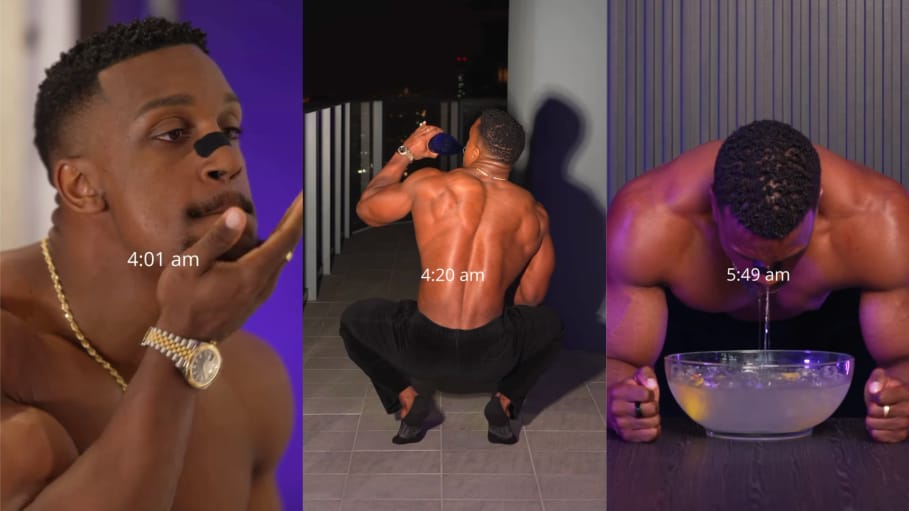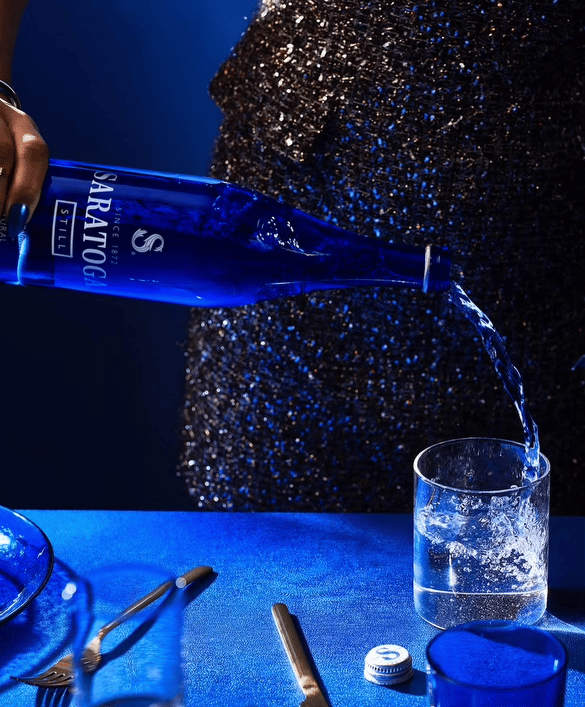- Mighty Consumer Notes
- Posts
- A Billion Views, Blue Bottles and Bananas: Ashton Hall and Saratoga Water's Viral Moment
A Billion Views, Blue Bottles and Bananas: Ashton Hall and Saratoga Water's Viral Moment
Did Saratoga cash in on its sudden social capital or blow its moment of internet fame?
A Scroll Stopping Routine
Last week, the internet couldn’t stop talking about Ashton Hall, a Miami-based fitness influencer whose hyper-curated, extreme morning routine video sent social feeds into a frenzy and racked up over a billion views across major platforms. In the clip, Hall runs through his meticulously structured ritual: a 3:50 a.m. wake-up, morning prayer, journaling, mouth taping, and push-ups before sunrise. But what really captured viral attention was his dramatic face dunk into a bowl of ice water — filled from a blue glass Saratoga bottle — and his unconventional skincare routine, which includes rubbing a banana peel across his forehead.
The video exploded online with — 77,000 reposts on X, countless TikTok stitches, and over 1 billion total views across major platforms. Suddenly, Saratoga’s iconic bottle became the digital icon and then internet meme of the moment. It showed up in influencer skits, parody routines, and even got a shout-out from MrBeast.
Through the digital commotion, Saratoga’s social team remained notably silent. This sparked a debate: did Saratoga’s marketing team miss a big opportunity for viral growth, or not?

Moments Ashton Hall’s viral morning routine
What Saratoga Did (and Didn’t) Do
For clarity, Ashton’s video was not a paid promotion — he featured Saratoga organically, using it as a status symbol. Still, when a product becomes the internet’s favorite prop overnight, it’s up to the brand to decide whether — and how — to ride the wave.
Saratoga 's response? Subtle. Behind the scenes, their CMO Kheri Holland Tillman said the brand was “thrilled” by the attention and had reached out to Hall. But publicly, Saratoga stayed mostly silent. No viral tweets. No big campaign. Just one minimalist Instagram post saying “plunge if you must”.
To some, this felt like a missed opportunity. Why not ride the wave? Why not drop a limited edition “Morning Routine” bottle or create a fun collaboration while the moment was hot?
But to others, Saratoga played it smart — keeping its luxury image intact without veering into meme-chasing chaos.
The Debate: Clout or Class?
Luxury brands walk a fine line when they go viral. On one side, there's free attention, access to a new Gen Z audience, and the chance to inject relevance, humor, and accessibility into a legacy name. Conversely, there's the risk of overexposure or coming off as inauthentic and as the internet says “cringe.”
Saratoga, founded in 1872, has long been the water of white tablecloth restaurants — subtle, premium, and not shouting for attention. Leaning too far into the meme could’ve cheapened that image.

Saratoga’s luxury aesthetic
Did Saratoga Blow its Main Character Moment
Marketing pros are split. Some argue Saratoga should’ve moved faster, spotlighted Hall, and created content that met the moment. As digital strategist Kunle Campbell wrote, “A creator just gave them more cultural capital than any agency could — for free. And they let it pass.”
Others think Saratoga made the right call. By not overreacting, they avoided looking desperate and let the public do the work. And guess what? They still won: Instagram followers spiked, Google searches surged, Saratoga bottles sold out on Amazon and the parent company Primo’s stock jumped 16%.
My Take
By playing it cool, Saratoga made the right call. In the age of meme marketing and reactive brand behavior, the temptation to jump on a viral wave is massive. However, for a luxury brand creating satirical content that appeals to a wide audience and maintains long established luxury positioning is a nearly impossible needle to thread.
Importantly, the risk of getting it wrong can far outweigh the reward.
A brand’s Instagram in many ways reflects a brand's digital catalog and mood board. Saratoga’s Instagram page contains carefully selected images of luxury such as bottles next to Michelin Star Meals or in service at elegant weddings. If Saratoga had rushed to post memes, force a collab, or over-brand the moment, it could’ve come off as inauthentic, desperate, or even tone-deaf. The internet is quick to turn on brands, especially “luxury brands” that seem like they’re trying too hard.
For a product that thrives on elegance, timelessness, and quiet prestige, trying to be the “funny brand” overnight could have eroded years of brand positioning. Instead, Saratoga did what luxury does best: it let the people do the talking. The product spoke for itself in the video and internet memes and copy cat videos have organically boosted brand awareness.
In today's marketing ecosystem, Saratoga's strategy is a good model for luxury brands. Leverage creators and their communities of fans to promote a product. These networks of relationships will share a message organically and thus more effectively.